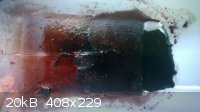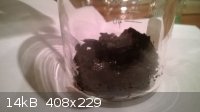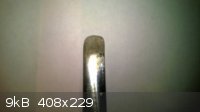| Pages:
1
2 |
sternman318
Hazard to Others
  
Posts: 121
Registered: 21-4-2011
Member Is Offline
Mood: No Mood
|
|
Addition of sodium bromide to copper sulfate solution
I have some unexplained chemistry...
When you add sodium bromide crystals to a solution( ive only tested it with somewhat dilute solutions), a dark brownish-violet solution forms and
lingers around them, but dissolves and loses its color when the solution is stirred. Even after adding copious amounts of NaBr, the brown color
appears, then completely dissappears when stirred. The solution appears somewhat greenish, almost like that of copper chloride. I wish to do a few
more experiements
Add a NaBr solution to a CuSO4 solution
Repeat, but with an acidified CuSO4 solution
Add CuSO4 crystals to a NaBr solution
Butttttt, I nearly wasted all of my NaBr in the process of the initial experiment ( time to make a run to Walmart haha).
Does anyone know what is occuring? Could I be forming elemental bromine, in a reaction analagous to that of iodine and a copper solution?
|
|
|
Jor
National Hazard
   
Posts: 950
Registered: 21-11-2007
Member Is Offline
Mood: No Mood
|
|
In very concentrated bromide solutions, copper forms a dark purple/violet bromocomplex, but this is only at very high concentration. For example, when
you add some copper sulfate crystals to 40% HBr, you get a dark violet solution, wich however turns green when you dilute it.
|
|
|
sternman318
Hazard to Others
  
Posts: 121
Registered: 21-4-2011
Member Is Offline
Mood: No Mood
|
|
New invisible ink?
http://www.youtube.com/watch?v=7WlGIQUzvUA
Excuse the use of a toilet and my inability to speak ( no sleep). And note the solution is as it appears in the video, I am not sure why I called it
blue.
Does anyone know what the formula is, specifically? I think I am going to try to get some crystals out of the remaining solution
|
|
|
LanthanumK
Hazard to Others
  
Posts: 298
Registered: 20-5-2011
Location: New Jersey
Member Is Offline
Mood: No Mood
|
|
It does appear to be a bromine complex with the copper.
My Wal-mart does not have sodium bromide in it.
[Edited on 7-6-2011 by LanthanumK]
|
|
|
m1tanker78
National Hazard
   
Posts: 685
Registered: 5-1-2011
Member Is Offline
Mood: No Mood
|
|
Quote: Originally posted by LanthanumK  | It does appear to be a bromine complex with the copper.
My Wal-mart does not have sodium bromide in it.
[Edited on 7-6-2011 by LanthanumK] |
Lowe's has it in the pool chemical section (outside/garden). It's sold in small packets; the larger containers have some organic bromo compound (can't
remember ATM).
Tank
|
|
|
sternman318
Hazard to Others
  
Posts: 121
Registered: 21-4-2011
Member Is Offline
Mood: No Mood
|
|
Yup, pool section is where it's at! Apparently people use bromine as an alternative to chlorine in their pools. If only they sold sodium iodide -_-
|
|
|
entropy51
Gone, but not forgotten
    
Posts: 1612
Registered: 30-5-2009
Member Is Offline
Mood: Fissile
|
|
Well, they do, sort of.
|
|
|
LanthanumK
Hazard to Others
  
Posts: 298
Registered: 20-5-2011
Location: New Jersey
Member Is Offline
Mood: No Mood
|
|
Reduction of NaI*I2 (tincture of iodine) may produce NaI. Around here, 1 fl oz of NaI*I2 is readily available.
|
|
|
sternman318
Hazard to Others
  
Posts: 121
Registered: 21-4-2011
Member Is Offline
Mood: No Mood
|
|
Really? I've been looking for that- where do you get it? I have only seen to have been able to find povidone-iodine solution, but have not bothered
trying to work with that because I really wouldn't know what I waqs doing haha. Though, I think I should just order some online, probably end up being
cheaper.
|
|
|
LanthanumK
Hazard to Others
  
Posts: 298
Registered: 20-5-2011
Location: New Jersey
Member Is Offline
Mood: No Mood
|
|
I bought it at Walgreens or CVS, in my area. It is about the same price online as in those stores.
|
|
|
sternman318
Hazard to Others
  
Posts: 121
Registered: 21-4-2011
Member Is Offline
Mood: No Mood
|
|
So I have had my solution sitting out to slowly evaporate. Everyday it is getting darker, going from the nice pale green to a brownish color. however,
when you cool in down it, surprisingly, goes back to the pale green color. Allowing it to return to room temperature yields the brown solution again.
This all seems quite confusing to me. However, looking at the wikipedia page for copper chloride...
"Aqueous solution prepared from copper(II) chloride contain a range of copper(II) complexes depending on concentration, temperature,and the presence
of additional chloride ions."
I am going to go ahead and assume that this is the case, just with bromide instead. So my question is, how would I go about crystallizing this
solution? even small amounts of it do not seem to dry up, and remain as dark brown drops. Should I be worried about heating the solution? I am
somewhat apprehensive towards heating solutions that I am unfamiliar with, after trying to dehydrate a solution of NaNO3 and accidently evolving NO2,
i believe.
[Edited on 10-6-2011 by sternman318]
|
|
|
Arthur Dent
National Hazard
   
Posts: 553
Registered: 22-10-2010
Member Is Offline
Mood: entropic
|
|
Quote: Originally posted by sternman318  | | ...when you cool in down it, surprisingly, goes back to the pale green color. Allowing it to return to room temperature yields the brown solution
again... |
Welcome to the magic of Copper chemistry. Try something cool, just add a bit of hydrogen peroxide to your brown solution, and it should turn a bright
emerald green!
Robert
--- Art is making something out of nothing and selling it. - Frank Zappa ---
|
|
|
sternman318
Hazard to Others
  
Posts: 121
Registered: 21-4-2011
Member Is Offline
Mood: No Mood
|
|
Robert- What should the above do? I dont want to waste my solution because I am trying to dry it out xD Or maybe I will just prepare some more later
But...
Copper is crazy, let me just say that.
I have accidently stumbled upon a method to create what I think is verdigris , but I dont think that that is very useful haha. But it is a very pretty seafoam.
I have a gorgeous blue/purple solution, but my poor lab practices means that I didnt record what I did to it, and have no idea what is in it 
And after trying to make some crude tetraaminecopper ions by adding what should be ammonium nitrate and then neutralizing with sodium bicarbonate, I
added some NaBr and it yielded a bright yellow precipitate. The precipitate dissolved when disturbed so I think that two things might be happening
1) that is the color of the solution/salt ( [Cu(NH3)4] Br2 ? or even [Cu(NH3)nBr4-n]
2) The copper is forming the [Cu(Br)4] 2-, and some ammonia is getting in there, making it yellow- which is pretty much the same thing as 1) haha.
If anyone would like to try and repeat the above using better chemicals and technique, I think the yellow color would persist if more bromide was
added. I, for some reason, dont have test tubes, so I end up wasting a lot of reagents trying to do things.
[Edited on 12-6-2011 by sternman318]
|
|
|
m1tanker78
National Hazard
   
Posts: 685
Registered: 5-1-2011
Member Is Offline
Mood: No Mood
|
|
| Quote: | | I, for some reason, dont have test tubes, so I end up wasting a lot of reagents trying to do things. |
Buy some cheap shot glasses at walmart. I think a 6 pack costs 2 or 3 bucks. They're nice for small scale experiments and allow complete visibility -
even fine precipitate that settles to the bottom and such. You can't heat stuff in them (such as over a burner), though!
Tank
|
|
|
sternman318
Hazard to Others
  
Posts: 121
Registered: 21-4-2011
Member Is Offline
Mood: No Mood
|
|
Well I cooked my solution, and made some asphalt!

Or CuBr2  But if any of you are working on your copper rainbow, here is your dark
dark purple/black copper! But if any of you are working on your copper rainbow, here is your dark
dark purple/black copper!
And thanks for the suggestion Tank!
|
|
|
sternman318
Hazard to Others
  
Posts: 121
Registered: 21-4-2011
Member Is Offline
Mood: No Mood
|
|
This was the color change when a pretty saturated solution was cooled ( furthest left) then allowed to warm to room temperature ( right)

[Edited on 17-6-2011 by sternman318]
|
|
|
woelen
Super Administrator
        
Posts: 7977
Registered: 20-8-2005
Location: Netherlands
Member Is Offline
Mood: interested
|
|
Yes, copper is also one of my favorite elements. I have done a lot of experimenting with it. Combinations of copper with halide ions are particularly
interesting. It also is worth experimenting in non-aqueous solvents. A funny thing is to dissolve some CuCl2 or some of your newly made CuBr2 (which
indeed is black, I have a commercial sample which looks very much like yours) in acetone or methanol.
Reduction of copper(II) in strong HCl or strong HBr also gives very interesting results. Exceedingly intensely colored complexes are formed, which
contain both copper(I) and copper(II). As reductor you can use plain copper wire, the copper reduces copper(II) to copper(I) and the metal also
becomes copper(I).
|
|
|
numos
Hazard to Others
  
Posts: 269
Registered: 22-2-2014
Location: Pasadena
Member Is Offline
Mood: No Mood
|
|
Copper Bromide > intresting properties?
So I've created quite a bit of Copper bromide from sodium bromide and copper II sulfate (both were concentrated solutions in water).
I wish to know how it functions. So at high concentrations the solution turns a beautiful maroon color, and when diluted turns green until it dilutes
to clearness. What's interesting is the sudden color change, it seems almost immediate without a gradient, (Unless you cool it in which case its
gradual change) although it's more likely that the gradient occurs at a very specific range over a few percentages, so more accurate tests will have
to verify that.
I've set it out to evaporate and so far I got this [see image 1] I've taken the somewhat dry crystals (image 2) and put them in a desiccator for now
as they don't seem to be air drying. Once they are completely dry I will run tests to see at what concentrations the color change occurs .
Any ideas of what actually happens? It's definitely not a chemical reaction that causes the color change right? Is this substance (the green and the
brown) indeed copper bromide CuBr? This picture I found is copper bromide so why isn't the (almost) dried version of CuBr similar to this greenish
color?

NOTE: The side product of this reaction is sodium sulfate and I did not recrystallize this product out as I am in high school, funding myself is not
easy and I have yet to obtain a hotplate. Would this compound contribute to this anomaly?
Also notice in image 3, my poor spatula... It was perfectly stainless - and now it's corroded, as I was scooping out the Copper bromide form the
evaporating pan this happened! It ate steel! 
  
[Edited on 2-27-2014 by numos]
|
|
|
bfesser
|
Threads Merged
26-2-2014 at 16:58 |
woelen
Super Administrator
        
Posts: 7977
Registered: 20-8-2005
Location: Netherlands
Member Is Offline
Mood: interested
|
|
The red/brown color is due to the complex ion CuBr4(2-), which contains copper in oxidation state +2.
The first picture you show is impure CuBr, which contains copper in oxidation state +1. Pure CuBr is white, the green color is due to partial
oxidation and this green material is CuBr with some copper(II) and oxide in it as well.
|
|
|
nezza
Hazard to Others
  
Posts: 324
Registered: 17-4-2011
Location: UK
Member Is Offline
Mood: phosphorescent
|
|
I suspect the colours are due to different copper complexes.
In dilute solution the hexaquo ion Cu(H2O)6 2+ ion dominates. This is the typical blue colour.
With chloride in concentrated solution the chloride complexes with copper giving Cu(Cl)4 2- ions. This gives a brown solution.
I suspect bromide acts similarly to chloride. Depending on the concentrations of the different ions many colours are possible.
|
|
|
Texium
Administrator
       
Posts: 4508
Registered: 11-1-2014
Location: Salt Lake City
Member Is Online
Mood: PhD candidate!
|
|
Just wanted to verify an idea that I had. Would making a bromine generator that passes bromine vapor directly onto CuO be an effective way of making
copper(II) bromide? It seems like that might be a cleaner way of producing it if it works. I thought that I would try it tomorrow, but I wanted to
make sure that I wouldn't be completely wasting my time and making a huge mess by doing so.
Also, is manganese dioxide a good enough oxidizer to liberate bromine when used with sodium bromide and conc. sulfuric acid? I previously used
potassium permanganate, but I am currently out of it.
[Edited on 9-7-2014 by zts16]
|
|
|
Zyklon-A
International Hazard
    
Posts: 1547
Registered: 26-11-2013
Member Is Offline
Mood: Fluorine radical
|
|
How would you ballance that equation?
CuO + Br2 = CuBr2 + 1/2 O2
Seems unlikely to go forward very well. Would elemental copper work, or would the reaction be to slow?
|
|
|
Texium
Administrator
       
Posts: 4508
Registered: 11-1-2014
Location: Salt Lake City
Member Is Online
Mood: PhD candidate!
|
|
Quote: Originally posted by Zyklon-A  | How would you ballance that equation?
CuO + Br2 = CuBr2 + 1/2 O2
Seems unlikely to go forward very well. Would elemental copper work, or would the reaction be to slow? |
2CuO + 2Br2 --> 2CuBr2 + O2
I read that elemental copper would work, but I thought it seemed like CuO might work better and react faster. Wikipedia says that it will react with
hydrobromic acid, so I thought that it might react with elemental bromine too?
Another thing I was just thinking about, would it be better to allow the bromine to react as a gas, or should I condense it and let it drip onto the
CuO?
|
|
|
Brain&Force
Hazard to Lanthanides
    
Posts: 1302
Registered: 13-11-2013
Location: UW-Madison
Member Is Offline
Mood: Incommensurately modulated
|
|
The problem is that HBr is an acid and CuO is a base so a neutralization takes place. Not so with bromine gas.
At the end of the day, simulating atoms doesn't beat working with the real things...
|
|
|
Texium
Administrator
       
Posts: 4508
Registered: 11-1-2014
Location: Salt Lake City
Member Is Online
Mood: PhD candidate!
|
|
Oh, of course! Should have realized that! (Late night chemistry planning = many careless mistakes)
Well, in that case, I'll make a hydrogen bromide generator instead of bromine. Using dilute sulfuric acid and no oxidizing agent should do the trick,
and then the HBr gas produced can react with the CuO. I will try this tomorrow.
|
|
|
| Pages:
1
2 |